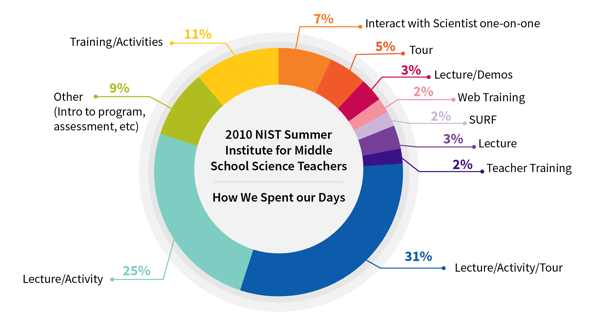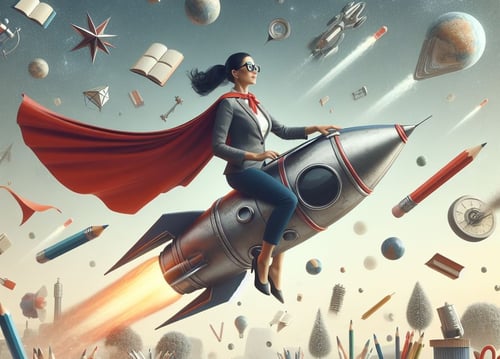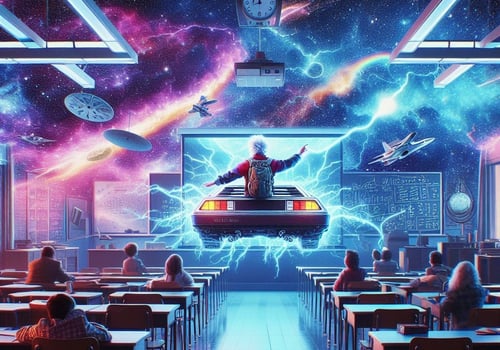Share this
Teaching Is Not A Desk Job, It's a Tech-Powered Adventure
by Orsi Szecsi on January 31, 2024
While the image of a teacher hunched over a desk, grading papers under a dim lamp, lingers in our minds, it's a faded photograph compared to the vibrant reality of teaching today. While the red-pen-wielding pedagogue may still hold a place in our collective memory, the reality of teaching today is far more dynamic, and, dare I say, exciting.
Teaching is not a desk job! It's a whirlwind of collaboration, creativity, and constant movement, a profession that requires a diverse skillset stretching far beyond textbook knowledge. Think of it as a high-wire act without a net, where every day is a new performance, balancing the needs of individual students with the demands of the curriculum, all while fostering a vibrant learning environment.
The vivid picture of the dynamic reality
A study by the National Center for Education Statistics found that teachers spend only 11% of their time in direct instruction, the traditional lecture format. The remaining 89% is a kaleidoscope of tasks, a testament to the multifaceted nature of the job: 22% planning and preparing, 19% grading and assessing, 13% engaging in professional development, and the rest divided between a symphony of responsibilities like classroom management, communication, and individual student support.

As you can see, the teacher's day is a symphony of responsibilities, demanding flexibility, adaptability, and a dash of improvisational genius.
But what does this look like in action?
Imagine a kindergarten teacher: Their day might begin with a carefully orchestrated morning meeting, a vibrant tapestry of songs, greetings, and shared experiences, where social-emotional learning and a sense of community are nurtured. Throughout the day, they transform into a facilitator of discovery, guiding curious minds through hands-on activities, messy play, and imaginative exploration. Science experiments erupt in colorful explosions, stories come alive through puppet shows and dramatic play, and the classroom becomes a wonderland of wonder and learning. They are also a detective and therapist, deciphering tantrums, mediating conflicts, and offering emotional support (and so much more). A gentle word, a reassuring hug, or a playful distraction can turn a meltdown into a moment of connection.
Now picture a 7th-grade science teacher: They start the day with a demonstration involving erupting volcanoes made from baking soda and vinegar (guaranteed to stain at least one lab coat). They then morph into a mad scientist, guiding students through slime-making experiments and potato battery construction. They become a human encyclopedia of weird animal facts, answering questions like "Do penguins have knees?" with a hilarious, "Technically, yes, but they're called 'tarsal joints' and they're super weird!" They are also a tech wizard, using virtual reality headsets to take students on field trips to the moon (while dodging virtual space sickness).

These are just glimpses into the multifaceted world of teaching. Every day is a unique adventure, filled with unexpected challenges and rewarding moments. It's about shaping young minds, igniting curiosity, and making a lasting impact on the world, one lesson, one interaction, one student at a time.
The redefinition of teaching
But the melody of modern education has evolved. Technology has become a new instrument in the teacher's toolbox. Interactive whiteboards replace dusty chalkboards, fostering visual learning, collaborative activities, and immersive simulations.
The future of education isn't just on the horizon, it's unfolding in classrooms in front of our eyes, right now. And the numbers paint a compelling picture:
- 70% of teachers report that technology helps them differentiate instruction to meet individual student needs (EdTech Review).
- 80% of students themselves say that technology makes learning more engaging and interactive (GetEdTech)
- Studies show that adaptive learning platforms can increase student learning gains by 20% (McGraw-Hill Education).
Educational apps and games transform challenging subjects into engaging and interactive experiences, while social media connects educators across the globe, sharing best practices and fostering support networks.
Imagine a history class, infused with AI: Students engage in Socratic dialogues with virtual historical figures, questioning Elizabeth I about her reign or debating scientific discoveries with Galileo Galilei himself. AI tutors, tailored to individual needs, patiently guide students through challenging concepts, offering personalized feedback and adaptive exercises. Virtual tours transport students to the heart of ancient Rome, battling alongside gladiators or exploring the bustling streets of medieval London.
Now picture a science lab, infused with VR: Forget stale diagrams and textbook illustrations. Students don virtual reality headsets and journey inside the human body, dissecting virtual organs and witnessing the marvels of the immune system in action. They climb towering volcanoes, witness the Big Bang's explosive birth, or dive into the ocean depths, encountering dazzling coral reefs and the majesty of marine life.

Educational apps, gamified challenges, and AI-powered language learning platforms transform dry memorization into immersive adventures. Students conquer fractions through thrilling math battles, unlock the secrets of photosynthesis by building virtual ecosystems, and master foreign languages through interactive games and conversations with AI-powered language partners.
But technology isn't just about bells and whistles. This tech-infused symphony empowers teachers to:
- Personalize learning: Tailor lessons to individual strengths and weaknesses, ensuring every student dances to their own unique rhythm.
- Foster collaboration: Break down geographical barriers, connecting students across the globe for virtual projects and cultural exchanges.
- Ignite curiosity: Go beyond the textbook, transforming dry facts into vibrant experiences that spark a lifelong love of learning.
The teacher remains the conductor, the one who orchestrates the learning, weaving technology, and traditional teaching into a cohesive masterpiece. Let's celebrate the dynamic symphony of modern education, where technology amplifies the teacher's voice, creating an unforgettable learning experience that prepares students for the ever-evolving future.
Teaching is not a job for the faint of heart. It's a calling, a passion, and an adventure. So, the next time you see a teacher, don't offer them an ergonomic chair and motivational posters. Offer them a tech upgrade that will make their days more than a little easier and watch their students' engagement and curiosity skyrocket.
References
Hanacek, N. (n.d.). Summer institute time pie chart. NIST. Retrieved January 25, 2024, from https://www.nist.gov/image/summer-institute-time-pie-chart
EdTech Review. (2022, April 27). Teachers Leverage Tech to Differentiate Instruction, Report Finds. Retrieved January 26, 2024, from https://www.prnewswire.com/news-releases/new-survey-majority-of-teachers-cite-edtech-as-key-to-supporting-diverse-learners-while-reducing-workloads-301900817.html
GetEdTech. (n.d.). Benefits of Technology in Education Retrieved January 26, 2024, from https://www.edapp.com/blog/the-benefits-of-technology-in-education/
McGraw-Hill Education. (2019, October 30). How Adaptive Learning Impacts Student Outcomes. Retrieved January 26, 2024, from https://www.mheducation.com/news-insights/press-releases/study-shows-significant-improvement-student-outcomes-adaptive-technology.html
Share this
- December 2025 (3)
- November 2025 (1)
- October 2025 (4)
- September 2025 (2)
- August 2025 (6)
- July 2025 (9)
- June 2025 (8)
- May 2025 (6)
- April 2025 (4)
- March 2025 (4)
- February 2025 (1)
- May 2024 (1)
- March 2024 (1)
- February 2024 (1)
- January 2024 (3)
- November 2023 (1)
- October 2023 (1)
- September 2023 (4)